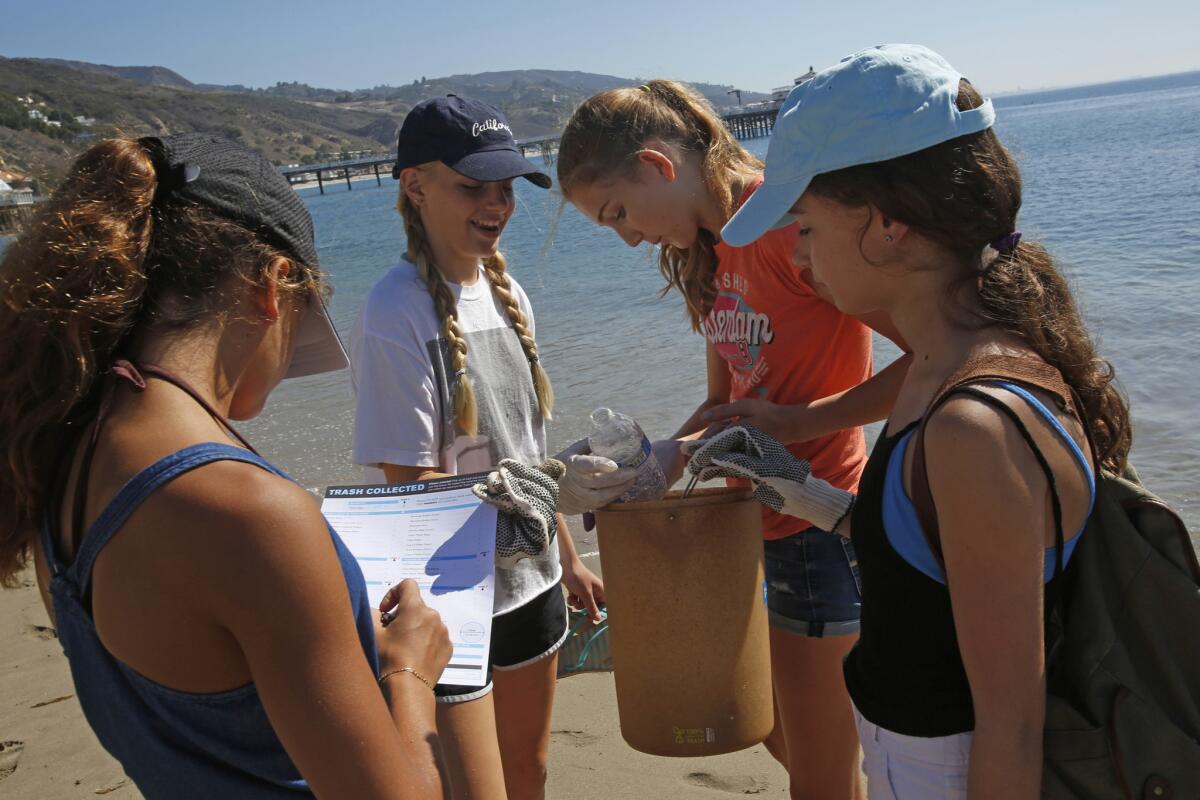Beach cleanup nets 21,300 pounds of trash, and wallet with $100

From left, Immaculate Heart Middle School students Daisy Salinas, Olivia Nickerson, Violet Marko and Rebecca Cohen log in a plastic bottle they found on Malibu beach as part of the cleanup.
- Share via
Malibu Lagoon State Beach is an intersection where urban runoff meets the sea in a system of brackish marshes that are valuable Southern California wildlife habitat for migrating waterfowl, shorebirds and fish, including federally endangered steelhead trout.
It is also a receptacle for tons of flotsam and discards at the mouth of Malibu Creek, which drains a 150-square-mile watershed in the Santa Monica Mountains and the San Fernando Valley.
On Saturday, more than 200 volunteers descended on the 110-acre site to wipe it clean of an array of trash — chip bags, water bottles, bottle caps, fishing line — and mark Los Angeles County’s 26th annual beach cleanup.
Among them was Lily Sychaleune, 36, of Toronto, who quickly filled a bucket with shards of glass, candy wrappers, straws and chunks of blue, red and yellow plastic.
“It seems like so much innocuous junk,” she said, “but it’s polluting a gorgeous stretch of coastal habitat and killing its wildlife.”
Alec Sant and Brooke Haim, both 17, who attend El Camino Real High School in Woodland Hills, removed beer bottles, cigarette butts and prescription bottles.
The catch of the day may have been a rusty, 7-foot-long steel sign post yanked out the muck at the water’s edge by Jeremy Sanchez, 14, of South El Monte High School. It weighed about 15 pounds.
They were among an estimated 10,000 volunteers who collected ocean-bound trash at more than 50 Los Angeles County sites between Malibu and Compton. The event is coordinated by the nonprofit organization Heal the Bay in conjunction with the California Coastal Commission and the Los Angeles County Department of Beaches and Harbors.
Over the last two decades, coastal cleanup participants have collected more than a million pounds of trash in the region — roughly the weight of a fully loaded Boeing 747, said Matthew King, a spokesman for Heal the Bay.
Half a mile south of the lagoon, 78 scuba divers collected hundreds of pounds of garbage, crab traps and fishing equipment from the pylons and sandy bottom beneath Malibu Pier.
Barbara Gentile-Crary, a member of the Los Angeles County Sheriff Department’s dive reserve team, emerged from the waves with a 12-inch carving knife.
“Last year, we found a revolver,” she said, shaking her head in dismay, “which was turned over to law enforcement authorities.”
Of particular concern was derelict fishing gear — monofilament line, nets, poles, toxic lead sinkers and plastic lures made to last thousands of years — that have become deadly snares for marine life. Pylons wrapped in fishing line and dangling lures continue to entangle seals and fish, killing them.
Elsewhere, 70 volunteers armed with trowels and wearing heavy work gloves spent the morning making sand dunes near Los Angeles International Airport more comfortable for federally endangered El Segundo Blue butterflies by removing 2,001 pounds of weeds, including Russian thistle, mustard and ice plant.
By day’s end, the overall effort had collected 21,310 pounds of trash, covering 60 miles of territory. Among the most unusual finds, the mayor of Agoura picked up a wallet that contained $100 cash at Medea Creek in the west San Fernando Valley. The mayor vowed to reunite the wallet with its owner.
Walking along the shore at Malibu Lagoon, Dana Murray, senior coastal resources manager for Heal the Bay, found a sea slug stranded on the sand.
Tossing it back into the waves, she said, “Back you go, to a coastline that is a little healthier than it was yesterday.”
Hoy: Léa esta historia en español
More to Read
Sign up for Essential California
The most important California stories and recommendations in your inbox every morning.
You may occasionally receive promotional content from the Los Angeles Times.











